You’ve heard all the buzz about artificial intelligence and how it can transform your business. But before diving in, you need to understand as much as possible about the AI app development cost.
Sticker shock awaits you if you fail to grasp the factors affecting the price. Don’t let that be you! Arm yourself with knowledge before approaching vendors. This guide breaks down everything from rates for AI engineering to cloud computing expenses.
We’ll walk you through typical project pricing, where to find savings, and what adds to the tab. Most importantly, you’ll gain the clarity needed to budget wisely. So, how much does it cost to build an AI solution? Let’s find out!
AI Market Overview: How It Changes with Time, and What Industries Use Innovations the Most
The artificial intelligence market is exploding. AI technologies like machine learning and deep learning are changing industries and our way of living. According to Statista, the global AI technology market is projected to reach 305.9 billion USD in 2024 compared to only 108.4 billion USD in 2020.
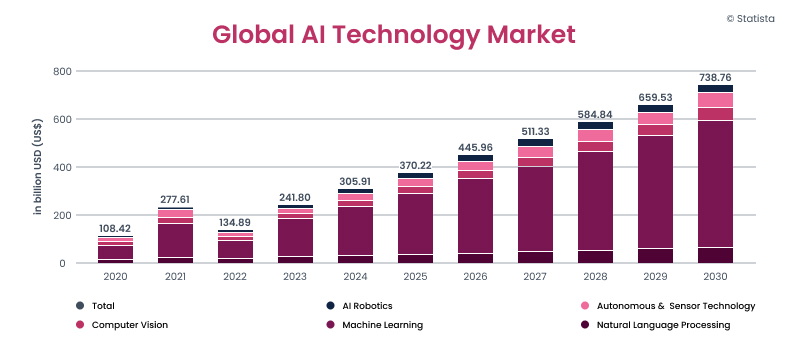
AI apps and software are in high demand, especially from large enterprises, but it’s not the limit. With generative AI, innovations become accessible to nearly any business. Check out these figures.
Statista’s market research states that the generative AI niche is likely to reach 66.6 billion USD in 2024, which is almost 22% of the overall AI market. In just three years, 2027, this market size is expected to double to 131.8 billion USD!
At Chi Software, we specialize in Generative AI consulting, empowering businesses to harness these transformative technologies. Our expertise allows us to unlock new possibilities in data-driven insights, personalized customer experiences, and operational efficiencies. Whether you’re a startup or a multinational corporation, our tailored solutions can help you stay ahead in the rapidly evolving landscape of AI innovation.

As an AI app development company, we’ve seen interest in AI solutions has skyrocketed over the past few years. More and more businesses are looking to use innovative technologies to solve myriad issues, from process automation to customer experience enhancements.
As a result, an AI model has applications in nearly every sector, from healthcare and transportation to finance and education. Here is the breakdown of the industries that benefit from AI-powered tools the most:
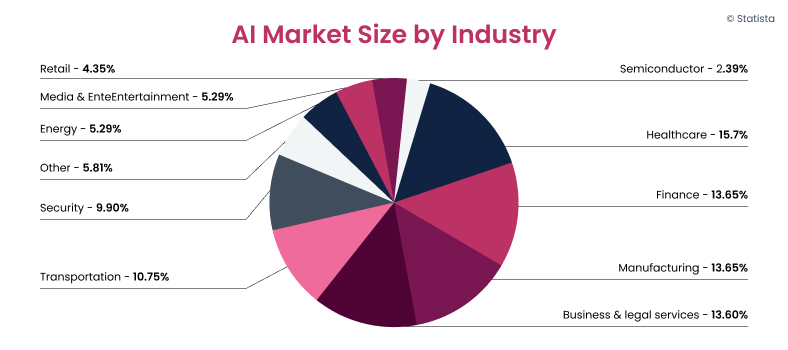
But how exactly do businesses use artificial intelligence? These are the most popular types of AI-powered applications that our clients want to develop.
- Chatbots and virtual assistants to improve customer service and experience. Chatbots can handle basic customer queries for a lower cost and more efficiently than humans thanks to immediate responses.
- Image recognition software for facial recognition, diagnosing medical conditions, and identifying products. Hence, security, healthcare, and retail businesses are drastically changing their operations by implementing their AI model.
- Predictive analytics tools to forecast trends and outcomes. Predictive analytics can anticipate customer behavior, equipment failures, and market changes to help businesses gain a competitive edge.
- Robotic process automation (RPA) software to automate repetitive, mundane tasks. RPA bots can complete data entry, accounting, and customer onboarding faster and more accurately than humans. Humans, at the same time, can take up more challenging and creative tasks.
What AI expertise do you need? Find out in our guide!
Read more
AI App Development Cost Factors: What Has the Biggest Impact on the Price?
Building an AI-powered app is an investment, and its actual cost can vary significantly based on your app’s features and complexity. But not only them. Let’s not waste a minute to figure out all the details.
Factor 1: Type of AI
The specific type of AI you want to implement has a major impact on the AI app development cost. Some simple AI apps powered by machine learning models are more affordable than those powered by complex deep learning neural networks. Chatbots are typically cheaper than computer vision solutions. Robotic systems and autonomous vehicle technologies are on the higher end of the spectrum.
Factor 2: Amount of Data
Your AI model requires massive amounts of data to learn and improve. The more training data you can provide, the more accurate and useful your AI-powered system will become. However, data collection, cleaning, labeling, and management are difficult, time-consuming, and pricey. For startups or smaller companies, the data costs can prove prohibitive. Look for ways to start with a smaller, targeted data sample and scale up over time.
Factor 3: Integration Complexity
Integrating an artificial intelligence app into your existing infrastructure, software, and business processes adds to the total cost. The more complex the integration, the higher the price tag.
For example, incorporating an AI model into a legacy system written in an outdated programming language is more difficult and expensive than integrating AI into a modern, API-based platform. Consider how much your current systems can support AI before getting started.
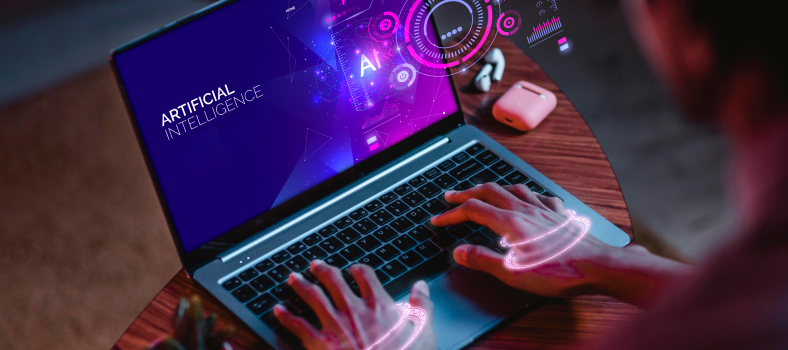
Factor 4: Customization Level
Off-the-shelf tools are the most affordable. As you add custom features, integrations, training data, and models tailored to your needs, AI app development cost climbs rapidly. Completely custom AI solutions built from scratch are the most expensive. Find the right balance between customization and out-of-the-box functionality for your business requirements and budget.
Factor 5: Regulatory Compliance
When developing an AI model, it’s important to play by the rules set by data privacy regulations, industry standards, and ethical guidelines. And guess what? Staying compliant involves extra steps of implementing data encryption, access controls, and audit trails to track data use. These measures add to the AI app development budget but are crucial for building user trust and avoiding hefty fines for non-compliance.
Do you want to discuss AI development estimation with engineers? It's easier than you think!
Book a free call
Factor 6: Deployment and Maintenance
Deploying an artificial intelligence system and providing ongoing maintenance adds to the total cost. Hosting AI solutions on robust infrastructure with fast processing power and storage implies monthly payments. Maintenance, which includes monitoring, troubleshooting issues, retraining models, and software updates, also requires engineering time.
Factor 7: Team Experience
An experienced AI app development team will likely charge higher rates than newcomers to the field. However, skilled engineers can also help reduce the AI development cost through optimized processes and by avoiding common mistakes. They can recommend practical solutions and caution against over-engineering.
For critical AI-powered systems, the additional investment in a seasoned development team is often worthwhile. For less complex projects, a lower-cost team or even one machine learning engineer may suffice if properly managed.
Your first step is to discuss all these factors with seasoned specialists. If you want, you can consult multiple development teams. Regardless of your goals, an intro call is always a good idea and won’t cost you any money. Leave us a message to start a conversation and get all your questions answered!
AI App Development Cost Breakdown
The total AI development cost will depend on the complexity of your app and the features you want to include. So, don’t be surprised by wide pricing ranges. As with any custom software, AI app development follows a typical process.
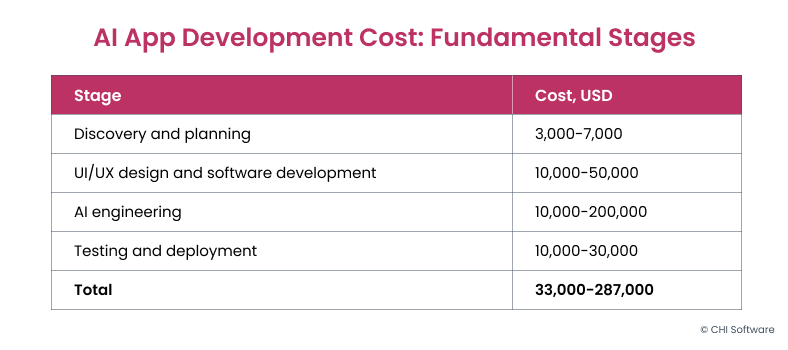
Discovery and Planning
This initial development process phase involves meetings with an engineering team to determine the scope of your project, set key milestones, and provide an estimated cost. For an AI-powered app, the discovery process aims to identify how machine learning, speech recognition, or natural language processing (NLP) can be leveraged to meet your needs.
At this stage, we usually collaborate with clients in two formats:
- Pre-sale activities to provide project estimation based on thorough research and the market’s current state;
- A separate discovery process if you want to validate your idea and find out if it’s doable, with no subsequent design or engineering.
The discovery and planning may take two weeks or more and will cost you between 3,000 USD and 7,000 USD.
UI/UX Design and Software Development
User experience (UX) and user interface (UI) design are key to the success of any app. They define how your solution will look from the outside, i.e., for your customers. Regarding AI apps, the design must facilitate natural and intuitive interactions between humans and machines. What a task!
When design is ready, we proceed with the development itself. Here, we mean “traditional” coding which takes place before the AI part.
Complex apps with their core functionality will be on the higher end of the range, around 20,000 USD to 50,000 USD. AI-powered apps with a simple interface and basic features can cost between 10,000 USD and 30,000 USD.
15+ Innovative Ideas for AI Mobile App Development for Startups
Follow this link
AI Development Process
This is where the real work happens and a big portion of the budget is spent. AI app development requires data scientists, machine learning engineers, and software developers to build and integrate AI algorithms into an app.
AI app development typically costs around 10,000 USD if it’s a simple proof of concept (PoC) and can go up to 200,000 USD or more for highly complex apps. Exact pricing will depend on the number of app features and the amount of customization needed.
Testing and Deployment
Rigorous testing is essential to ensure AI apps function as intended before launching. This stage of the work can add from 5,000 USD to 20,000 USD. Deploying your solution will also need to be budgeted for 5,000 USD to 10,000 USD. The cost heavily depends on the deployment environment (cloud or on-premise). If you pick on-premise deployment, expect the price to rise.
Depending on the complexity, you can expect to pay an overall cost of between 33,000 USD and 287,000 USD or more for custom AI development.
Strategies to Optimize Your AI App Budget
You may be surprised to learn that optimizing the AI app development cost is possible. Not every vendor will tell you that, but we’re here to uncover the hidden parts.

Focus on the Core AI Features First
It’s easy to get carried away with exciting features when developing AI apps. However, it’s important to focus first on the core functionality that will drive user adoption and meet your key business goals.
For many small businesses, an affordable option is to start with basic features to validate the concept of your AI model before investing in more advanced functionality.
Afterall, artificial intelligence is a microservice, which you can integrate into an already existing app. In this case, you can skip the second stage (UI/UX design and software development). This option will cost you around 10,000 USD to 50,000 USD.
If you need to demonstrate the user interface to potential investors, for example, we can create a clickable prototype and imitate user journey using Figma.
Choose a Flexible Tech Stack
The technology behind AI development is constantly evolving, so select platforms and tools that are flexible enough to adapt to changes. Some options offer drag-and-drop interfaces, pre-built AI models, and simple integration with your existing systems.
These options may require higher upfront spending but can save the AI app development cost in the long run versus rebuilding your app from scratch when new technology emerges. They also allow you to start simple and add complexity over time.
Start with an Off-the-Shelf AI Model
Developing AI apps from scratch requires a major investment of resources. Instead, consider using pre-trained AI models you can customize for your needs. Many AI-powered platforms offer models for common use cases like image recognition, natural language processing, and recommendation engines. You can fine-tune these models with your own data to achieve solid results without building from the ground up. As your app matures, you can consider developing your custom AI model.
Optimize your AI development costs with a trusted team by your side
Let's talk
Consider a Pilot to Prove the Value
If your budget is limited, focus on a pilot version of your AI model to prove its value before investing heavily. Build a basic app with simple functionality (minimum viable product), launch it to a select group of users, and analyze the results.
If the pilot achieves your key performance indicators, you’ll have data to support expanding your budget and additional development effort. If not, you can make adjustments to better meet user needs before a wide release. A phased approach like this reduces financial risks.
Outsource to AI Specialists
Developing an AI app requires specialized skills that can be hard to find and expensive to hire for your in-house team. Consider outsourcing some or all of your AI app development to an external vendor.
Outsourcing providers often have more experience in emerging technologies, larger teams of experts, and lower costs due to economies of scale. They can also help ensure your app is developed efficiently and meets high-quality standards. Look for providers with experience developing an AI app for your industry and business size.
How AI App Development Looks in Real Life: CHI Software’s Insights, Challenges, and Solutions
AI applications in business are highly versatile. Algorithms can improve customer relations or, on the other hand, optimize internal operations. Our development team has experience in various scenarios. Let’s examine their valuable insights.
AI App Development to Improve User Engagement: Digital Assistant for the Banking Industry
If you’re a bank in the UK, prepare for changes! Although the British financial industry seems traditional at first glance, it is now becoming highly innovative. AI is a go-to technology if you want to stay afloat, so the benefits of using it are obvious. Our client thinks the same.
So, who is our client?
It is a forward-thinking financial organization that aims to be ahead of the game and outrun its competitors. Developing an AI app is the answer if you have similar goals in mind. So, their next step was partnering with a vendor with a solid experience in fintech development.
What does the final solution have to offer?
CHI Software had to deal with a complex set of features that touch on several aspects of the client’s work. Here are more details on this point.
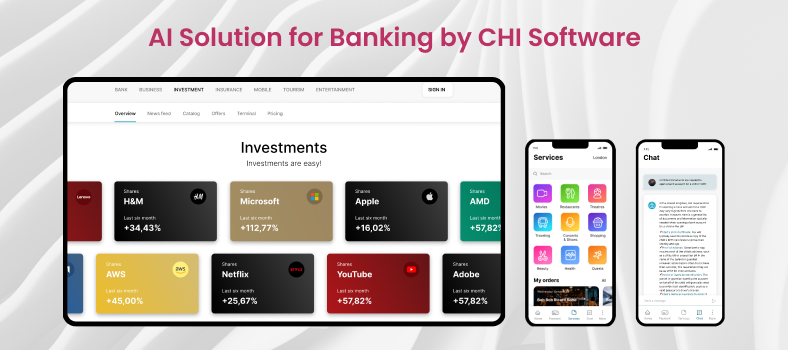
- AI-powered chatbot. We developed a smart chatbot using the GPT model capabilities. This task is relatively easy but can drastically change the customer experience. Now, the bank’s clients get personalized support with no human involvement. Moreover, the chatbot can process general queries and pass sensitive issues to human agents.
- Tasks automation. We won’t surprise you by saying that banking has a lot of routine, repetitive operations under the hood. Our task was to identify as many such operations as possible and streamline them with AI automation. Document processing and report generation now take several minutes.
- Smart search and filtering. Our app development team created secure on-premise software for data processing to help prevent data leaks that can occur in the cloud. Our core focus was retrieving, generating, and filtering data using necessary security precautions.
- Custom entity extraction. Simply put, this feature helps our AI assistant recognize and extract specific patterns or data pieces. With NLP models, the solution can extract information about financial instruments (stocks, bonds, etc.), transaction details, banking products, and so on.
Our Generative AI experts have also upgraded the solution’s technology stack, optimized software performance, improved data serialization, and more.
As you can see, developing an AI app can touch on many (if not all) of your business processes. What results may it bring?
How has our client benefited from our AI app development services?
- The client’s digital AI assistant got even better thanks to a team effort that boosted its performance.
- Switching to Protobuf seriously upgraded the assistant’s security, making it faster and safer.
- The banking AI chatbot, along with smart filtering, did a fantastic job of attracting new customers and keeping them engaged.
- In just one year, the client bank saw an impressive 33% revenue increase during 2022.
If you believe in the power of digital assistants as much as we do, find out more details about this case study on our website.
The Big Change: Top AI Trends Transforming the Business World in 2024
Read more
AI App Development for Streamlined Operations: Robotic Process Automation (RPA) Solution for Logistics
Many businesses have no choice but to adapt innovations to survive market shake-ups. We’ve seen a lot of this in the post-pandemic period, and this tendency is unlikely to disappear. This time, we’re going to discuss process automation as a means to optimize operations and keep up with customers’ growing demands.
So, who is our client?
Our client is a Canadian logistics company looking for a way to reduce human staff during the pandemic and cut business costs with that. The thing is, a lot of the company’s employees were busy with routine document processing, which can be easily optimized with relevant AI software.
To meet the client’s demands, our development team offered an RPA tool that could help avoid a costly software project.
What does the final solution have to offer?
Our engineers created an intelligent RPA tool using several AI technologies in their workflow: machine learning, natural language processing, computer vision, and optical character recognition. This technology mix allows the solution to do the required paperwork much faster and in a more productive manner. Here is how it works:
- A person uploads a PDF document to the solution’s dashboard.
- The AI software can automatically identify pages in several document categories, such as invoices, proofs of delivery, letters of carrier assignments, and others.
- The AI model can “read” documents and extract information from invoices, bills of lading, and proofs of delivery.
- Users can also use RPA to classify documents and recognize required fields.
- This tool can recognize and read visuals like QR codes and logos.
- The system continuously learns based on the new document types and fields.
As the project progresses, we’re working on an app to organize document images (not only text information) and extract information from them. We’re also setting up a service on Azure to automatically read and handle email messages and a web app to sort through the processed results.
Wrapping Up
By understanding the fundamental factors that influence the AI app development cost, you can now make smarter decisions when the time comes to build your own solution.
Remember to clearly define your goals, choose the right software developers for the job, understand what’s driving price fluctuations, and allocate enough resources to support ongoing maintenance.
With the power of AI apps on your side, you’ll be ready to transform your business and stand out from the competition. So don’t let artificial intelligence cost deter you – lean into this exciting technology and let it fuel your company’s future success.
But that’s all words. Message the CHI Software team via this contact form to start real actions. Our expertise covers almost every AI technology, and we can help you adopt innovations and prepare for the future.
About the author
Alex Shatalov
Data Scientist & ML Engineer
Alex is a Data Scientist & ML Engineer with an NLP specialization. He is passionate about AI-related technologies, fond of science, and participated in many international scientific conferences.









